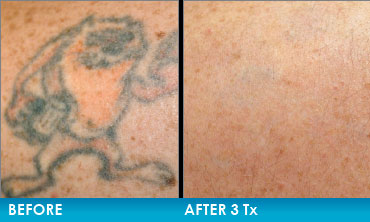Tattoo Removal
The History of Decorative Tattooing
Decorative tattooing in humans is an ancient art form the origins of which can be traced as far back as the stone and bronze ages. A study conducted in 1991 found that between 9-11% of adult men in the United States have tattoos however greater than 50% regret having them and would seek removal if possible. Unfortunately, at the present time, tattooing remains popular with role models such as athletes and entertainers, serving as strong impetus for teenagers and young adults to seek tattoos.
Previous Methods of Tattoo Removal
Unfortunately, tattoo removal using most non-laser methods has significant disadvantages such as incomplete pigment removal, non-selective tissue destruction and unsatisfactory cosmetic results such as atrophic or hypertrophic scarring. Older methods of tattoo removal have involved the application of caustic chemicals such as Phenol Sulphuric acid. All of these methods are associated with a high incidence of scarring and pigmentation disturbances and are no longer used.
Slightly more refined methods of tattoo removal have included abrasion with salt (salabrasion), cryosurgery, dermabrasion, electrocoagulation, and the use of an infrared coagulator. All of these procedures are associated with significant scarring and in most instances the result of tattoo removal looks much worse than the tattoo itself. Conventional surgical methods have been used to treat tattoos however their use is limited to the removal of small tattoos. Surgical removal of large tattoos usually yields disastrous results and therefore has been abandoned.
Lasers for Tattoo Removal
The use of lasers to remove tattoos began in the early ’90s with the first report of successful tattoo removal using Q-Switched Ruby lasers. Ruby lasers are still quite useful for tattoo removal however, they must be used carefully in dark skin type individuals since coincident melanin absorption at 694nm can be associated with prolonged but most often temporary loss of pigmentin treatment areas.
In 1991 the Q-Switched Neodymium-YAG laser was introduced for tattoo removal. Theoretically, this laser with a longer wavelength (1064nm) would allow deeper penetration and at the same time exhibit less melanin absorption. Early studies using this laser showed that it was very effective in removing dark blue black ink seen in amateur and professional tattoos and especially useful in removing dark ink from cosmetic eyeliner tattoos. The addition of a frequency doubling crystal to this laser, provided laser output at 532nm or green light, which also aided the removal of tattoos containing red and orange ink.
At the present time the Q-Switch YAG laser is the workhorse of tattoo removal. Unfortunately, certain ink colors, most often, green do not respond to this laser necessitating the use of Ruby or Alexandrite lasers for complete removal. In 1992, a Q-Switched Alexandrite laser was introduced operating at a wavelength of 755nm. The Alexandrite crystal emits energy that is longer than the Ruby at 694nm and significantly shorter than the ND-YAG laser at 1064nm. Excellent results have been obtained in the treatment of blue-black and green tattoos using this laser.
Other uses for tattoo lasers are removal of traumatic tattooing resulting from mechanical penetration of foreign particles into the body. These tattoos are most likely associated with falls or “road rash” and can be easily eliminated by treatment using tattoo removal lasers. In addition, unwanted or misplaced cosmetic tattoos such as eyeliner and lip liner tattoos can be removed by means of Q-Switched lasers. In summary, lasers available at the Center for Laser Surgery provide an excellent means of tattoo removal with little or no scarring. These lasers offer significant advantages over previous methods for tattoo removals and are presently the treatment of choice and standard of care for tattoo removal.

